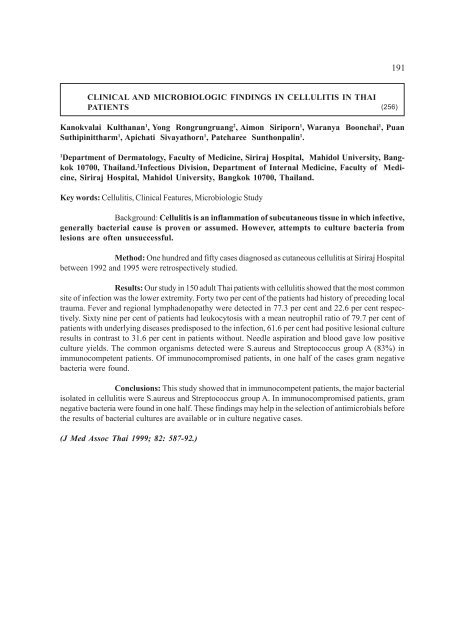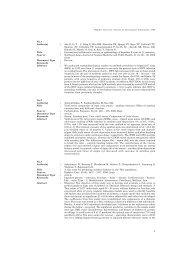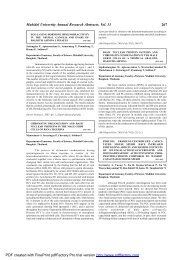THE OSTIA VENAE HEPATICAE AND THE RETHROHEPATIC ...
THE OSTIA VENAE HEPATICAE AND THE RETHROHEPATIC ...
THE OSTIA VENAE HEPATICAE AND THE RETHROHEPATIC ...
Create successful ePaper yourself
Turn your PDF publications into a flip-book with our unique Google optimized e-Paper software.
CLINICAL <strong>AND</strong> MICROBIOLOGIC FINDINGS IN CELLULITIS IN THAI<br />
PATIENTS<br />
Kanokvalai Kulthanan 1 , Yong Rongrungruang 2 , Aimon Siriporn 1 , Waranya Boonchai 1 , Puan<br />
Suthipinittharm 1 , Apichati Sivayathorn 1 , Patcharee Sunthonpalin 1 .<br />
1 Department of Dermatology, Faculty of Medicine, Siriraj Hospital, Mahidol University, Bangkok<br />
10700, Thailand. 2 Infectious Division, Department of Internal Medicine, Faculty of Medicine,<br />
Siriraj Hospital, Mahidol University, Bangkok 10700, Thailand.<br />
Key words: Cellulitis, Clinical Features, Microbiologic Study<br />
Background: Cellulitis is an inflammation of subcutaneous tissue in which infective,<br />
generally bacterial cause is proven or assumed. However, attempts to culture bacteria from<br />
lesions are often unsuccessful.<br />
Method: One hundred and fifty cases diagnosed as cutaneous cellulitis at Siriraj Hospital<br />
between 1992 and 1995 were retrospectively studied.<br />
Results: Our study in 150 adult Thai patients with cellulitis showed that the most common<br />
site of infection was the lower extremity. Forty two per cent of the patients had history of preceding local<br />
trauma. Fever and regional lymphadenopathy were detected in 77.3 per cent and 22.6 per cent respectively.<br />
Sixty nine per cent of patients had leukocytosis with a mean neutrophil ratio of 79.7 per cent of<br />
patients with underlying diseases predisposed to the infection, 61.6 per cent had positive lesional culture<br />
results in contrast to 31.6 per cent in patients without. Needle aspiration and blood gave low positive<br />
culture yields. The common organisms detected were S.aureus and Streptococcus group A (83%) in<br />
immunocompetent patients. Of immunocompromised patients, in one half of the cases gram negative<br />
bacteria were found.<br />
Conclusions: This study showed that in immunocompetent patients, the major bacterial<br />
isolated in cellulitis were S.aureus and Streptococcus group A. In immunocompromised patients, gram<br />
negative bacteria were found in one half. These findings may help in the selection of antimicrobials before<br />
the results of bacterial cultures are available or in culture negative cases.<br />
(J Med Assoc Thai 1999; 82: 587-92.)<br />
191<br />
(256)

















